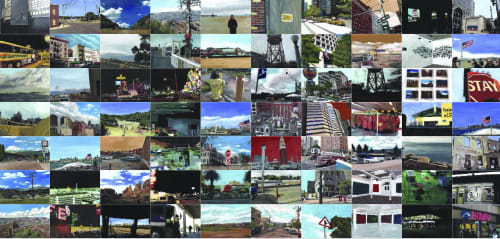Eamon O'Kane, Gerard Byrne, Alice Maher, Bernadette Cotter, Grainne Cuffe, Brendan Earley, Dnis Farrell, Denise Ferran, Paul Gregg, Karl Grimes, Ronan Halpin, Katie Holten, John Keating, Clare Langan, Rosie O'Gorman, Geraldine O'Reilly, Alan Phelan, Amanda Ralph, Orla Ryan, Katherine West
inter-changes is the first event in the Fulbright Commission's 50th Anniversary Celebrations. The exhibition gives a sampling of the artistic practices the Fulbright Commission has helped nurture and support with its scholarships to the United States. The twenty exhibiting artists have studied at some of the most prestigious universities in the US including Yale, New York University, School of the Art Institute of Chicago, the Whitney Independent Study Program, and Parson School of Design. As current practitioners in the visual arts, many are leaders in their field and have represented Ireland in several international events. Across the three generations of exhibiting artists, an inter-change emerges around ideas of history, representation, technique and process which are treated in remarkably different and dynamic ways. Compare, for example, the collaborative botanical research and performance work by Katie Holten made in Philadelphia with the exquisite etchings of flowers by Grinne Cuffe. Both artists share a passion for nature and its minutiae from distinctive aesthetic and environmental perspectives. Similarly the classical work traditions of charcoal drawing and clay ceramics pervade the work of John Keating and Katherine West. Both share a love of process and a fascination in archetypal forms which relate contrasting ideas of collective memory and the past. Contemporary understandings of the documentary image are explored and shared differently in the works of Gerard Byrne, Karl Grimes and Clare Langan. Their use of photography provides examples of how the narrative can destabilise the primacy of the image. They reveal assumptions about how
mass media and nature are constructed within parallel historical and cultural contexts. Modernist trajectories come into question through several artists. The mock-architecture of Brendan Earley strangely compliments the hard-edged grid paintings by Denis Farrell. Both are concerned with social space over pure historical whimsy. Form itself is called into question in the shape shifting sculpture by Paul Gregg and again championed in the new sculptures by Ronan Halpin. The gestural and perceptual impulses behind much contemporary practice are shown in the works of Rosie O'Gorman, Bernadette Cotter and Denise Ferran. They share divergent approaches to these ideas, responding both in abstract and personal ways. Contemporary lifestyles and histories are further explored through works by Amanda Ralph, Alan Phelan and Alice Maher utilising multiple techniques and new media. Subbuteo footballers act out Zidane's red card send-off, boy racers on video blend with papier-mâché heroes, while the apparent crisis of aging is covered up with moss and reversed with a small sleeping figure. A number of the artists are exhibiting works that were made while on their Fulbright grant. Orla Ryan investigates several representational tropes of film with her installation shot primarily in the New York subway system. Eamon O'Kane presents a travelogue of consumption, with postcard type paintings rooted in tourist snapshots and a video piece of the artist gorging and regurgitating a Swiss roll. Geraldine O'Reilly charts a history of emigrant correspondence using letters found during research in New York. Alan Phelan, Curator, inter-changes
Farmleigh Gallery opens during exhibitions from Thursdays to Sundays and Bank Holidays. Opening Hours: 10:00 am to 5:30 pm Due to official government use Farmleigh, including the Farmleigh Gallery, may be c occasion to the public. To avoid disappointment please visit our website or call +35 for regular updates.
Eamon O'Kane Fulbright awarded 1999 Parsons School of Design, New York The selection of paintings from Eamon O'Kane's AKA - After Kafka's America series were completed during and after his time in the US. They form part of a travelogue or commentary as he travelled across the country, fascinated by the landscape of consumption which is reflected in the postcard sized paintings and a later video work where the artist is gorging on a chocolate Swiss roll. O Kane works in many media which include painting, video, and animation. His work is often site specific or site generated and includes several residencies and commissions. O'Kane has exhibited widely in Ireland, UK, Germany, Switzerland and Denmark. He recently has had two solo exhibitions in Dublin.
'Eamon O'Kane's richly productive project AKA: After Kafka's Amerika has generated a profusion of art works in a range of media that includes painting, photography and video. Famously, Franz Kafka relied on secondary source material when writing his novel, Amerika, as he never actually visited the USA. In keeping with this preference for imaginative projection over recorded experience AKA, the video is prefaced by a cautionary epigraph from the critic Jonathan Culler: 'Things are never expected to be real; rather things are read as signs of themselves, idealized and often frustrated.'
Caomhin MacGiolla Leith
